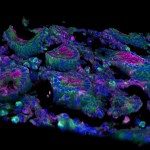Link to Pubmed [PMID] – 12957815
Front Biosci 2003 Sep; 8(): d1170-85
African green monkeys (AGMs) belong to a superspecies that include the following four species: vervet (Chlorocebus pygerythrus), grivet (C. aethiops), sabaeus (C. sabaeus) and tantalus monkeys (C. tantalus). Each species carries a distinct SIVagm subtype, named SIVagm.ver, SIVagm.gri, SIVagm.sab and SIVagm.tan but remain clinically asymtomatic throughout their life. SIVagm needs the CD4 molecule and a chemokine-receptor, usually CCR5, Bonzo and/or Bob, for cell entry. Molecular and functional analyses of AGM CD4 and CCR5 revealed evidence of a true co-evolution between SIVagm and their natural hosts. The V3 loop of the SIVagm external glycoprotein is relatively conserved compared to that of HIV-1, but equally a determinant for coreceptor usage. SIVagm are able to replicate in stimulated peripheral blood mononuclear cells (PBMC) and macrophages. Efficient replication of SIVagm in vitro is associated with a cytopathic effect. SIVagm regulatory proteins show low amino acid identities with that of HIV-1, but many functions are conserved. The Tat protein of SIVagm is a transactivator of SIVagm LTR, albeit to a relatively lesser extent than Tat of HIV-1. Vif of SIVagm increases virus infectivity in AGM PBMC, demonstrating that SIVagm Vif is a positive regulator of virion infectivity. Vpr of SIVagm shares with HIV-1 Vpr its ability to transactivate the viral LTR, causes cell cycle arrest in AGM cells and facilitates nuclear import of pre-integration complexes and infection of non-dividing cells. AGM Vpr has been reported to also induce apoptosis, but the pathways involved in the mechanisms leading to apoptosis seem to be divergent compared to HIV-1 Vpr. SIVagm.ver3delta nef shows limited replicative capacity in vitro and in vivo, which suggests that Nef of SIVagm provides activation signals to the cells that facilitate SIV replication. The levels of plasma viral RNA in naturally infected AGMs are in a wide range (6.10(6) RNA copies/ml), with many animals displaying steady-state levels of >10(6) RNA copies/ml levels, which in humans are associated with progression towards AIDS. Viral load per se therefore is not directly linked with pathogenicity. SIVagm-infections differ, however, from pathogenic HIV/SIVmac infections by a low viral load in peripheral lymph nodes. These relatively low localized tissue viral load levels are associated with lack of signs of detectable immunopathology. More detailed studies on the precise immunological environment during natural SIV infections, especially during primary infection, and on the interactions between SIVagm and host-specific cellular proteins are needed to better understand the mechanisms by which these naturally SIV infected nonhuman primate species are protected against progression towards AIDS.

